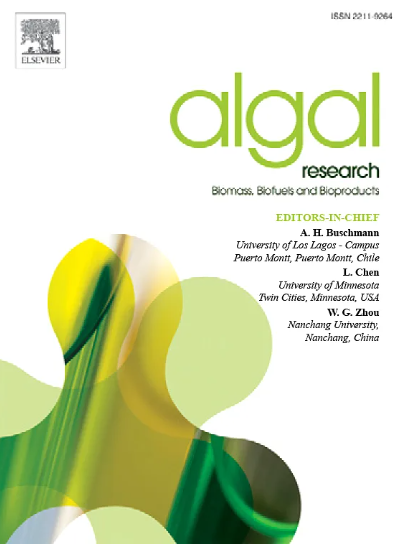用红花苷分光光度法定量蓝藻胞外聚合物(EPS)
IF 4.5
2区 生物学
Q1 BIOTECHNOLOGY & APPLIED MICROBIOLOGY
Algal Research-Biomass Biofuels and Bioproducts
Pub Date : 2025-06-09
DOI:10.1016/j.algal.2025.104134
引用次数: 0
摘要
EPS由多种微生物合成,对生态系统中微生物的生长和生存起着至关重要的作用。培养液中EPS的定量通常是通过大量乙醇或丙酮沉淀后的重量分析来完成的。这种用少量培养滤液进行的分析容易出错。本研究介绍了一种简单的基于分光光度计的技术,用于定量细胞分泌到生长介质中的溶解EPS。利用从Synechocystis sp. IMMT47中提取的EPS,该方法包括用红花素染色和沉淀细胞分泌的蓝藻EPS。随后,将离心后的沉淀颗粒在水中重组,并在519 nm处测量滤液的吸光度。该方法得到的EPS浓度与吸光度的线性关系与先前报道的基于阿利新蓝的定量方法进行了比较。以丙酮为标准,用常规重量法定量EPS,比较分析效果。R2值为0.97,p值为0.33,不同定量方法间无显著差异。本实验通过评估重组吸光度,熟练地定量溶解的细胞外多糖。与传统的重量法和阿利新蓝法相比,该方法对小体积样品具有更高的灵敏度和重复性。这种方法不仅简化了EPS定量,而且最大限度地减少了样品损失和试剂消耗。由于其简单,成本效益和可及性,该方法有望推进微生物EPS研究,特别是在生态和生物技术研究中。这种创新的方法对于推进微生物中EPS的生物地球化学研究具有重要的潜力。本文章由计算机程序翻译,如有差异,请以英文原文为准。
Spectrophotometric quantification of cyanobacterial extracellular polymeric substances (EPS) using safranin
EPS are synthesized by various microorganisms and they play crucial roles in microorganism's growth and survival within their ecosystem. Quantification of EPS in culture liquid is generally done through gravimetric analysis after precipitation using large quantities of ethanol or acetone. Such analyses with a small volume of culture filtrate are error-prone. This study introduces a straightforward spectrophotometer-based technique for quantifying dissolved EPS secreted by cells into the growth medium. Utilizing EPS extracted from Synechocystis sp. IMMT47, the method involves staining and precipitating cyanobacterial EPS secreted from cells, with safranin. Subsequently, the precipitated pellet after centrifugation was reconstituted in water and the absorbance of the filtrate solution was measured at 519 nm. The obtained linear relationship between the concentration of EPS and absorbance from this method is compared with the earlier reported alcian blue-based quantification approach. Conventional gravimetric quantification of EPS using acetone was used as a standard to compare the efficacy of analysis. The R2 value was found to be 0.97 with a p-value of 0.33, showing no significant variation among the quantification methods. The presented assay proficiently quantifies dissolved extracellular polysaccharides by evaluating reconstituted absorbance. Compared to the conventional gravimetric and alcian blue-based methods, the safranin assay exhibited higher sensitivity and reproducibility for small-volume samples. This approach not only streamlines EPS quantification but also minimizes sample loss and reagent consumption. Given its simplicity, cost-effectiveness, and accessibility, this method holds promise for advancing microbial EPS research, particularly in ecological and biotechnological studies. This innovative method has significant potential for advancing research on the biogeochemistry of EPS in microorganisms.
求助全文
通过发布文献求助,成功后即可免费获取论文全文。
去求助
来源期刊

Algal Research-Biomass Biofuels and Bioproducts
BIOTECHNOLOGY & APPLIED MICROBIOLOGY-
CiteScore
9.40
自引率
7.80%
发文量
332
期刊介绍:
Algal Research is an international phycology journal covering all areas of emerging technologies in algae biology, biomass production, cultivation, harvesting, extraction, bioproducts, biorefinery, engineering, and econometrics. Algae is defined to include cyanobacteria, microalgae, and protists and symbionts of interest in biotechnology. The journal publishes original research and reviews for the following scope: algal biology, including but not exclusive to: phylogeny, biodiversity, molecular traits, metabolic regulation, and genetic engineering, algal cultivation, e.g. phototrophic systems, heterotrophic systems, and mixotrophic systems, algal harvesting and extraction systems, biotechnology to convert algal biomass and components into biofuels and bioproducts, e.g., nutraceuticals, pharmaceuticals, animal feed, plastics, etc. algal products and their economic assessment
 求助内容:
求助内容: 应助结果提醒方式:
应助结果提醒方式:


